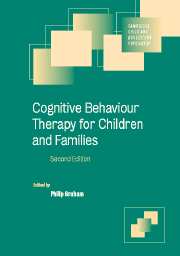Book contents
- Frontmatter
- Contents
- List of contributors
- 1 Introduction
- Part I Developmental cognitive theory and clinical practice
- 2 Cognitive behaviour therapy for children and adolescents: some theoretical and developmental issues
- 3 Cognitive behavioural therapy in developmental perspective
- 4 Psychological therapies: a family of interventions
- Part II Engagement and assessment
- Part III Client groups
- Part IV Applications in psychosocial adversity
- Part V Applications in specific child and adolescent psychiatric disorders
- Part VI CBT applications in preventive interventions
- Index
- References
4 - Psychological therapies: a family of interventions
Published online by Cambridge University Press: 21 August 2009
- Frontmatter
- Contents
- List of contributors
- 1 Introduction
- Part I Developmental cognitive theory and clinical practice
- 2 Cognitive behaviour therapy for children and adolescents: some theoretical and developmental issues
- 3 Cognitive behavioural therapy in developmental perspective
- 4 Psychological therapies: a family of interventions
- Part II Engagement and assessment
- Part III Client groups
- Part IV Applications in psychosocial adversity
- Part V Applications in specific child and adolescent psychiatric disorders
- Part VI CBT applications in preventive interventions
- Index
- References
Summary
Psychological therapies: shared paths to success?
At last count, there were over 300 brand-name psychotherapies for youths (Kazdin, 2000). Although most of these interventions have never been tested in clinical trials, results of hundreds of studies indicate that youth therapy can be of significant benefit. In broad-based meta-analyses, effect sizes for child and adolescent psychotherapy are in the moderate to large range (Casey and Berman, 1985; Weisz et al., 1987; Kazdin et al., 1990; Weisz et al., 1995), on par with the effects of adult therapy and many medical interventions (Weisz and Weersing, 1999). In addition to this global good news, in recent years the field has made strides in identifying empirically supported treatments (ESTs) with evidence of efficacy for specific youth problems and diagnostic profiles.
In 1998, the year of the last formal EST review, over two dozen promising treatments were identified for youth anxiety, depression and behavioural problems (see Lonigan and Elbert, 1998). The existence of this growing family of efficacious interventions raises a provocative question: how many therapies for youth are ‘enough’? Or, phrased differently, how useful is new treatment development for the science and practice of psychotherapy?
For some diagnoses, such as bipolar disorder in childhood and adolescence, treatment development is still clearly the first order of business. However, for many youth problems, there is a growing consensus that expanding the family of psychotherapeutic interventions may be less useful than gaining deeper understanding of the treatments that we already have (e.g. g. Kazdin, 1995; Russell and Shirk, 1998; Weisz et al., 1998; Kazdin, 2001).
- Type
- Chapter
- Information
- Cognitive Behaviour Therapy for Children and Families , pp. 48 - 64Publisher: Cambridge University PressPrint publication year: 2004



